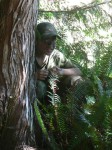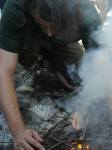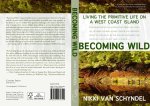This article is based on the Conservation College subsistence fishing curriculum developed by Master Fisherman, Lead Instructor & Wild Chef Charlie Borrowman. Join us at our next fishing workshop, usually scheduled in mid June.

Many people view fishing as a recreational past time, but at the Conservation College, we are a bit more pragmatic. It’s a subsistence activity for us. We train ourselves and others to follow laws and traditions to fish local rivers, foothill lakes, and the Salish Sea. Target animals include trout including steelhead, salmon, bass, surf perch, flounder, sole, dogfish shark, lingcod, crab and other shellfish.
We also attempt to be honorable harvesters, learning to avoid polluting the waters like using chiseled stones rather than lead weights, reducing pain on fish by putting them out of their misery as soon as possible, and utilizing everything we catch. We also enjoy cleaning and cooking our fish in various ways to eat the fruits of our labor:)
As salmon season revs up in the rivers, crabs are still legal to catch and are growing in size; piers are hot with bottomfish and other exciting creatures caught day and night, and finally cutthroat trout start to spawn when the waters cool down, we start gathering our food to preserve for the winter.
Fishing Hatchery-Stocked Rainbow Trout in Lowland Lakes – The Powerbait Rig
As most rainbow trout found in lakes are stocked by state hatcheries, they are used to eating hatchery pellets. Dough baits such as powerbait are usually the most effective way to catch them. Place a glob of power bait on a size 6 or 8 hook at the end of the line with a weight 1-2 feet behind it. The distance between the hook and weight will determine how far off the bottom the bait will float. To avoid putting lead in the water, use bigger non-lead splitshot weights since size doesn’t matter: they are far enough away from the hook to scare fish.
Alternatively, powerbait can be fished on a hook hanging under a bobber for the same presentation. Cast the bait out and let it sit until you get a bite. Remember, the powerbait is for hatchery-raise trout, so just look up on your state Fish & Widlife website when they stock lakes, and catch your daily limit from April-June until the lake becomes unproductive in July. Hatchery-raised fish eat any time of day.
Fishing Wild Trout (River Steelhead, Cold Water & Sea Cutthroat) – Fly Fishing Rig

The wilder the trout, the pickier they get about when to feed. Wild trout will often only bite in the very early morning and evening times. Trout biting times can vary by location but often starts as early as 4:30am and usually stays productive until 8 or 9 am. The last hour before dark can also be a productive time to fish. The reason: Insects they eat are most active at those times and daylight allows them to be seen.
Most fish are eyesight dominant, especially wild trout like cutthroat which hang out down where the water is super cold, watching the surface for insects to make their distinctive ripples. That’s why fly fishing is required to catch them. In fly fishing, specialized lures called flies are tied to the end of your line and whipped back and forth over your head to simulate a flying insect. After whipping the fly around, flick the rod to cast the fly and let it drop gently to the water.
Look for deep holes in streams or areas with cover where fish may hide. If you land a fly in an area a few times without any bites, move on to a new spot. Wild trout are far more shy than their hatchery raised cousins. Be very quiet and avoid standing in places where you are visible from the hiding spot you are targeting. The bite is most productive in early morning and late evening.
People think fly fishing is a mystery. Basically, just watch the water and if fish start to “jump” – they are actually grabbing insects of the surface – then that’s when you want to fly-fish for subsistence. If they aren’t jumping, then you are recreationally fly fishing which is very relaxing and enjoyable, but unproductive. So, just buy yourself one of those cheap fly fishing kits in a package for about $35 especially if they come with a few flies since flies (hooks with threads made to look like flies trout eat) are otherwise expensive if you buy your own individually, then find a lake that hasn’t been developed on it’s shores, tributary streams where they spawn haven’t been clearcut/damaged, and you can find a place where you can throw your line.
Lake Fishing from the Shore (largemouth and smallmouth bass, panfish like bluegills and crappies, self-reproducing rainbow trout, perch and catfish)
Gear you’ll need includes a medium weight spinning rod (normal rod and reel), size 8 hooks, size 6 hooks, size 2/0 hooks, plastic grubs, swimbaits, spoons, sinkers, splitshot weights, swivels, beads, leader line, powerbait, and nightcrawlers (big worms). First, some definitions:
Carolina Rig: Used to fish bait, plastic grubs/worms, and other swimbaits on the bottom. The rig is made by putting a sliding egg sinker and a bead on the line, followed by a swivel and a 1-2 foot leader with a hook and chosen bait. Depending on the bait used it can be left to sit on bottom, or twitched and retrieved.
Texas Rig: A variation of the carolina rig where the bait is hooked so that the point and barb are not poking out. This allows it to be dragged through dense weeds and other debris without getting tangled or snared.
Bass and panfish tend to enjoy structure such as downed trees and lillypads. Texas rigged worms, grubs, spoons, and swimbaits are all very effective when fished next to these structures. Cast the lures out and retrieve them at slow pace to entice a strike. Work as much water as you can to find where the fish are. Use size 2/0 hooks for bass, and size 6 or 8 for bluegill and other smaller panfish. These aggressive species will bite all day, but the bite is often better in the early morning or late evening.
Fishing for Salmon in Rivers

Once salmon enter the river systems, they are often targeted with drift rigs (also called corkies and yarn). A thin pencil lead drift weight is fished with a long leader. A foam corkie and bead are placed on the leader before the hook to float it off the bottom. Yarn is often tied to the hook to make it more noticeable to the fish. The rig is cast upstream and allowed to float freely down the river until it gets too far downstream. Then the rig is reeled in and the technique is repeated.
By the way, for wild river steelhead (trout) you can fly fish, or use a drift rig with a pencil lead/lead wire weight with a 2-4 foot leader. A corkie and bead are added onto the leader above the hook to float it off the bottom. Yarn can be tied to the hook to make it more appealing. Sometimes a large fly lure is used in place off the hook and yarn.
In coastal Pacific Northwest rivers, we can have 4 main salmon species. Remember, the salmon genus are basically fish which hatch from eggs in freshwater rivers, then are swept out to sea a few months later, live 2-5 years in the ocean, then return to their river of origin to spawn and die. Steelhead are not salmon; they are rainbow trout which, like most trout, can swim between fresh and saltwater sometimes at their pleasure, but often for spawning vs feeding reasons.
Some salmon can be landlocked and still reproduce. One of these is the kokanee, which are sockeye salmon living in lakes. The state does raise and stock a few dammed lakes with kokanee, but it’s not really a subsistence species here, and we don’t have many runs of sockeye in Western Washington river anymore, probably because rivers have been dammed and lakes have been developed, and sockeye require lakes in which to spawn. Unfortunate since it’s generally considered the best tasting salmon. Sockeye juveniles stay in lakes for over a year, and because they use freshwater year-round, they are susceptible to low water quality.
King salmon, also called Chinook, are still holding on in our rivers. Most of the legally catchable ones, however, were raised in tribal hatcheries, and you can tell the difference between those and the protected wild chinook by seeing if the adipose fin is clipped off or not. Hatcheries clip the juveniles before releasing them into the wild. They have a life cycle of 5 or more years, so some years are okay, other years are bad fishing, and like the state and tribes work together to do, you can look back at reports over 5-8 years to help predict what to expect over the next 5 years.
Silver salmon, also called Coho, usually run on a 3 year life cycle, and they are doing only a little better than the kings in our rivers. Dog salmon, also called Chum, are doing pretty well the further north you go, like in the Nooksack River. The life cycle of chum can vary from 3-5 years. and they are a great subsistence food since most people don’t like their taste. I can tell you they taste great on a grate over a fire in a survival situation!
The one salmon I can recommend sustainabely fishing for subsistence is the pink salmon, which are also called Humpies. They have a strict 2 year life cycle and interestingly, on a strictly odd-year run. No one has been able to tell me a good theory as to why there is no even-year run. You would think that back in history, some jakes would have broken into the even-year market. Pinks started mysteriously booming about 10 years ago, maybe due to habitat restoration efforts, or maybe they are like coyotes, thrive on disturbed habitats, but just needed strict fishing regulations to give them a chance to reproduce.
Pink runs peaked in 2013, were off in 2015 and their size had been cut in half probably due to lack of nutrients/food fish (including a new dead zone phenomenon usually found in warmer waters) that occurred in the eastern Pacific in 2014-15, and their return is predicted to be even less in 2017 but we’re hopeful that ocean nutrients/food fish are better this year. Just look for all the people standing on the shores of area rivers, and do what they do but don’t assume they know the fishing regulations. Always have a fishing regulation pamphlet on you and read it every time you go out. The rules and knowledge contained therein will help you catch more fish, and avoid fines!
Pier and Jetty Fishing
The most accessible and productive subsistence fishing you can do in Western Washington is from saltwater piers. Your annual fishing and crabbing license will really pay off here, especially if you fish the incoming tide, or at night.
Target Species: Flounder, Surfperch, Rockfish, Salmon, Dogfish shark
Gear: Spinning rod, size 8 hooks, size 6 hooks, size 2/0 hooks, plastic grubs, swimbaits, spoons, big sinkers that won’t get caught on things like little lead sinkers tend to, splitshot weights, swivels, beads, leader line, steel leaders, buzz bombs, frozen shrimp, frozen squid, frozen herring.
High-Low Rig: This rig is specially designed to target the bottom of the water column. An appropriate sized weight is tied to the end of the line, followed by 1-4 hooks spaced at 1 foot intervals up from the weight.
Jighead/Swimbait Rig: A jighead is a specialized weighted hook designed to hold plastic grubs and other swimbaits. Jigheads and swimbaits with built in jigheads are simply tied to the end of the line and fished by casting and retrieving.

Flounder and sole are a flatfish species that spend most of their lives hiding on the bottom. They are best targeted with a high-low rig using a lead sinker and two or three size 6 hooks. Cut shrimp and squid are the best baits for this fish. Simply bait the hooks and throw the rig out. Wait for it to hit bottom and let it sit there until a fish bites. Flounder can be hesitant when they bite, so wait for a solid hit before reeling in. Reeling in too early will pull the bait out of their mouths before they have time to swallow it. Flounder can also be targeted with a carolina rig baited with a soft plastic grub or other swimbait. Best time to fish is an incoming tide.
Surfperch: Various species of surfperch can be found off of every pier, jetty, and beach on the west coast of the US. They are found very close to shore, often just behind the wave breakers. They can be targeted with a variety of rigs including high-low and carolina. From a pier, high-low rigs baited with shrimp or squid should be fished around pilings and other structure. Surfperch particularly love areas with rough surf, feeding on the little creatures churned up by the swirling water just behind the waves. When fishing from a beach, a carolina rig baited with a plastic grub or small piece of shrimp and cast just past the waves will often tempt a bite. Best time to fish is an incoming tide.
Rockfish and Lingcod: Usually only found in areas with plenty of large rocks and other solid submerged structures to hide in. These fish are highly aggressive and love live bait. A live anchovy or sardine allowed to swim freely on a hook is great for lingcod. Rockfish can be targeted with a high-low rig baited with shrimp or squid. Jigheads and other swimbaits are also very effective.
Salmon from Piers & Jetties: During salmon season, salmon can be found in large numbers feeding around piers and along the coast as they prepare to push up into the river systems to spawn. Buzz bombs and jigheads are very effective when fished with a simple cast and retrieve technique. Salmon in washington state usually need to be caught on barbless hooks. Always check your local regulations for special rules and area closures.
Dogfish are one of the most common sharks found in the Salish Sea. They are most often caught on high-low rigs baited with large chunks of fish or squid. It’s important to attach the hooks with steel leaders to prevent the dogfish from cutting the line with their teeth. Dogfish are nocturnal and will often only bite at night. Make sure to have a large net or crab pot that can reach the water to aid in landing them.
Crab: Go to any open pier curing crabbing season, usually July-August, watch and talk with people who are crabbing, study your fishing regs to make sure you don’t pick up their bad habits, and otherwise, just go buy what the successful people are using and do it, too!
This article is based on the Conservation College subsistence fishing curriculum developed by Master Fisherman, Lead Instructor & International Culinary Chef Charlie Borrowman. Join us at our next fishing workshop, usually scheduled in mid June.
For In-Depth Learning, Join Our Weekly Online Classes:
- Tuesday Classes focus on Herbal Medicine & Plant Crafts in the autumn season, followed by Gardening & Cooking Wild Edible Food Plants in the spring.
- Thursday Classes focus on Wilderness Survival & Bushcraft Skills in the Autumn Season, followed by Wildlife Tracking & Birding in the spring.
- Saturday Classes for all ages guide you through the Wolf Journey Earth Conservation Course – Book One: The Neighborhood Naturalist.












